 3D Web is the set of technologies that put user browsers in an online, interactive 3D environment.
3D Web is the set of technologies that put user browsers in an online, interactive 3D environment.
MOSES continues the tradition of contributing to the public good.
MOSES stands for Military Open Simulator Enterprise Strategy. It is an Open Simulator, 3D Web, virtual environment platform.
MOSES is now available to interested, relevant, DoD and non-DoD researchers from the U.S. Army Simulation & Training Center (STTC), under the auspices of Douglas Maxwell, STTC Science and Technology Manager for Virtual World Strategic Applications.
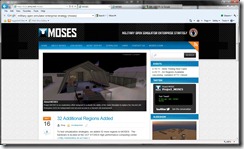 How did MOSES come about, and why is the U.S. Army offering it to researchers in enterprise, university, and other armed services, including the Air Force and the Navy?
How did MOSES come about, and why is the U.S. Army offering it to researchers in enterprise, university, and other armed services, including the Air Force and the Navy?
"MOSES started as a response to the vacuum Linden Lab created by canceling the Second Life Enterprise project. We had a significant investment in the platform that needed to be preserved," says Maxwell. "My colleagues told me how lucky I was to have access to a commercial non-military network to use for research and development of virtual trainers, with collaboration avenues to industry and academia. It is important to note that no classified or sensitive information is allowed on MOSES."
 Maxwell continues, "The purpose of my Virtual World Strategic Applications team is to augment the U.S. Army’s existing, regular, operations-grade virtual trainers. Each of these existing trainers does one thing very well. However, we need more flexibility. We need to blend multiple trainer attributes into a sort of multi-tool super trainer."
Maxwell continues, "The purpose of my Virtual World Strategic Applications team is to augment the U.S. Army’s existing, regular, operations-grade virtual trainers. Each of these existing trainers does one thing very well. However, we need more flexibility. We need to blend multiple trainer attributes into a sort of multi-tool super trainer."
"For example, our lab systems are able to produce craters in the terrain resulting from explosions. We are able to change weather and timing in challenge scenarios more powerfully, in real time. We are able to include chat between teams and commanders on different communication channels, as in real world circumstances. Teams can even interact with and build, in situ, in the lab trainer environment."
"All of these features are desirable for the new virtual trainers needed to meet the changing situation demands on modern warfighters."
Maxwell explains, "With the loss last year (2010) of Second Life Enterprise, I wanted to offer researchers in the field an Open Simulator research environment that would be of similar grade and security."
"I was able to acquire sixteen Hewlett Packard Blade servers that had just been decommissioned from another project. We refurbished them and brought them online on the open Internet so that I could give MOSES accounts on them. All that I ask is that users of the platform are doing relevant work to virtual-training systems."
"MOSES is highly relevant to our STTC exploratory initiative," explains Maxwell. "MOSES emulates the highly-successful Linden Lab content-creation-by-residents model. We have an excellent team of programmers and designers, but the new researchers signing up for MOSES outnumber us drastically. We benefit from their content creation and testing work on MOSES. They benefit from having a high grade, secure, good-to-go platform ready for use."
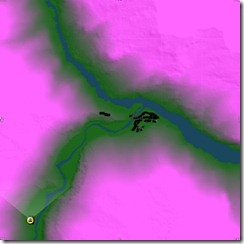 "What you put on MOSES, you own free and clear," says Maxwell. MOSES is also secure. "Even though on open Internet, these servers have security measures in place approximating (75%) what we achieved on SL Enterprise. MOSES is on the public Internet for good reason: to allow us all to expand, more efficiently, best practices in using Open Simulator and 3D Web virtual environments."
"What you put on MOSES, you own free and clear," says Maxwell. MOSES is also secure. "Even though on open Internet, these servers have security measures in place approximating (75%) what we achieved on SL Enterprise. MOSES is on the public Internet for good reason: to allow us all to expand, more efficiently, best practices in using Open Simulator and 3D Web virtual environments."
In fact, Maxwell has started a public MOSES website, blog, and email list to share best practices in the use of Open Simulator technology. This is a sorely needed boon for the expanded use of 3D Web, whether for research, commerce, military, art, or enterprise.
"Interest and logins since the first announcements have been high," says Maxwell, "higher than I expected. In addition, we brought online assets from The University of Central Florida STOKES High Performance Computing Center. MOSES now supports 96 separate simulator regions on 40 CPU cores."
 Maxwell has assigned over 100 non-Army user accounts so far, and is even assigning entire sims to approved research organizations. Maxwell clarifies, "In some ways, MOSES is a direct response to the loss of the Second Life Enterprise Beta product." SL Enterprise Beta was a fully-operational, behind-the-firewall, 3D Web solution that was developed by Linden Lab, with Maxwell’s assistance, to be 100% secure. Linden Lab cancelled the SL Enterprise program in 2010.
Maxwell has assigned over 100 non-Army user accounts so far, and is even assigning entire sims to approved research organizations. Maxwell clarifies, "In some ways, MOSES is a direct response to the loss of the Second Life Enterprise Beta product." SL Enterprise Beta was a fully-operational, behind-the-firewall, 3D Web solution that was developed by Linden Lab, with Maxwell’s assistance, to be 100% secure. Linden Lab cancelled the SL Enterprise program in 2010.
"MOSES allows the other SL Enterprise researchers to continue their work," explains Maxwell. "It would be a waste to let the content developed for SL Enterprise servers be deleted. Instead, it is preserved (in accordance with the terms of service) by migrating to MOSES."
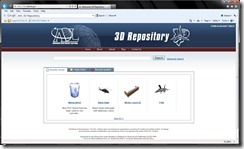 However, MOSES content migrated from SL Enterprise is relatively minimal. MOSES already contains 36 Afghan-terrain sims inherited from the earlier project. And MOSES is gaining new content every day from the work being added by new MOSES users.
However, MOSES content migrated from SL Enterprise is relatively minimal. MOSES already contains 36 Afghan-terrain sims inherited from the earlier project. And MOSES is gaining new content every day from the work being added by new MOSES users.
The HP servers are installed with standard OS software, available from www.opensimulator.org. The IBM server has special added software. "The Stokes server is running Intel’s Distributed Scene Graph (DSG). This allows ten times as many avatars, up to 1,000, on each super sim," says Maxwell.
How do you apply for an account, or a sim, or otherwise benefit from Maxwell’s MOSES project?
Maxwell explains, "Use the MOSES website, http://brokentablet.arl.army.mil/, to apply for an account, be added to our email list, and otherwise learn more."
"It’s important to remember," Maxwell adds, "MOSES is a research and development environment, not an operations environment. We will keep upgrading the platform, for example, as we learn new improvements in using OS. We have also enabled full-sim backups from your MOSES regions to your own organization hard drives."
Priority will be given to technology and / or military testing. "It doesn’t have to be a military project," explains Maxwell. "If you’re developing or evolving some cool new kind of technology, like bots, for example, that would be clearly relevant to the MOSES mission."
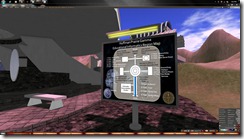 So far, Maxwell has assigned 18 sims for Air Force use and 4 sims for Navy use. Another 4 sims have gone to private research firms and several to individual qualified researchers. "I will keep assigning MOSES resources until they run out," says Maxwell.
So far, Maxwell has assigned 18 sims for Air Force use and 4 sims for Navy use. Another 4 sims have gone to private research firms and several to individual qualified researchers. "I will keep assigning MOSES resources until they run out," says Maxwell.
What will happen when MOSES resources run out, and will STTC and Maxwell continue to operate and grow the project?
Maxwell responds, "I like to think of MOSES as carrying on the tradition of military research contributing to the public good. The Internet itself is a direct descendent of military funded research (ARPANET). It’s possible that more resources will show up to be added to MOSES, as awareness grows through blog, email, articles, and word of mouth."
To learn more, visit the MOSES website.
Reference
MOSES
Main Page – OpenSim
STOKES HPCC at UCF
Distributed scene graph to enable thousands of interacting users …
History of the Internet – Wikipedia, the free encyclopedia
US Army Uses 3D Web To Train More And Cost Less « Sitearm
 Douglas Maxwell, MSME
Douglas Maxwell, MSME
Science and Technology Manager
Virtual World Strategic Applications
U.S. Army Simulation & Training Technology Center (STTC)
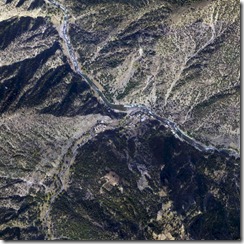

May 21, 2011 at 6:27 pm
[…] article adapted, with permission, from Sitearm. See also US Army Uses 3D Web To Train More And Cost Less.) #dd_ajax_float{ background:none repeat […]
June 16, 2011 at 7:13 pm
[…] spoke about theor MOSES Project and Big World […]
September 24, 2011 at 8:35 pm
[…] U.S. Army Offers MOSES 3D Web System for Non-Army Researchers – Sitearm Madonna […]
October 30, 2011 at 12:18 am
[…] U.S. Army Offers MOSES 3D Web System for Non-Army Researchers – Sitearm Madonna […]
October 22, 2012 at 3:10 pm
[…] […]
November 7, 2013 at 3:30 am
[…] Blog Item: https://sitearm.wordpress.com/2011/05/16/u-s-army-offers-moses-3d-web-system-for-non-army-researchers… […]